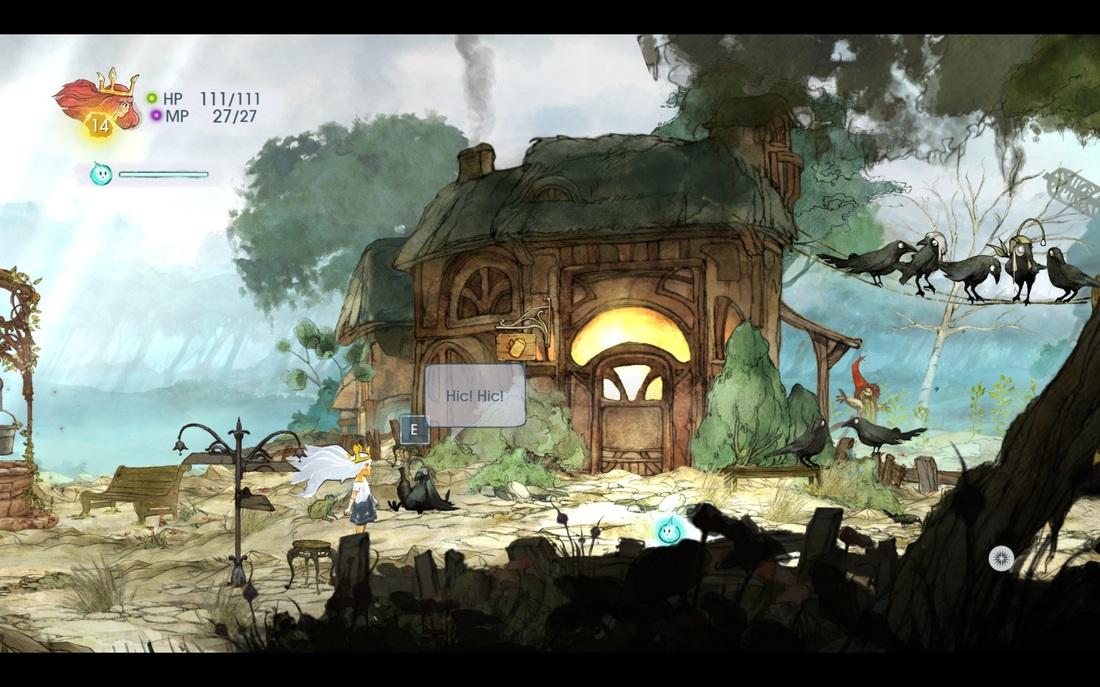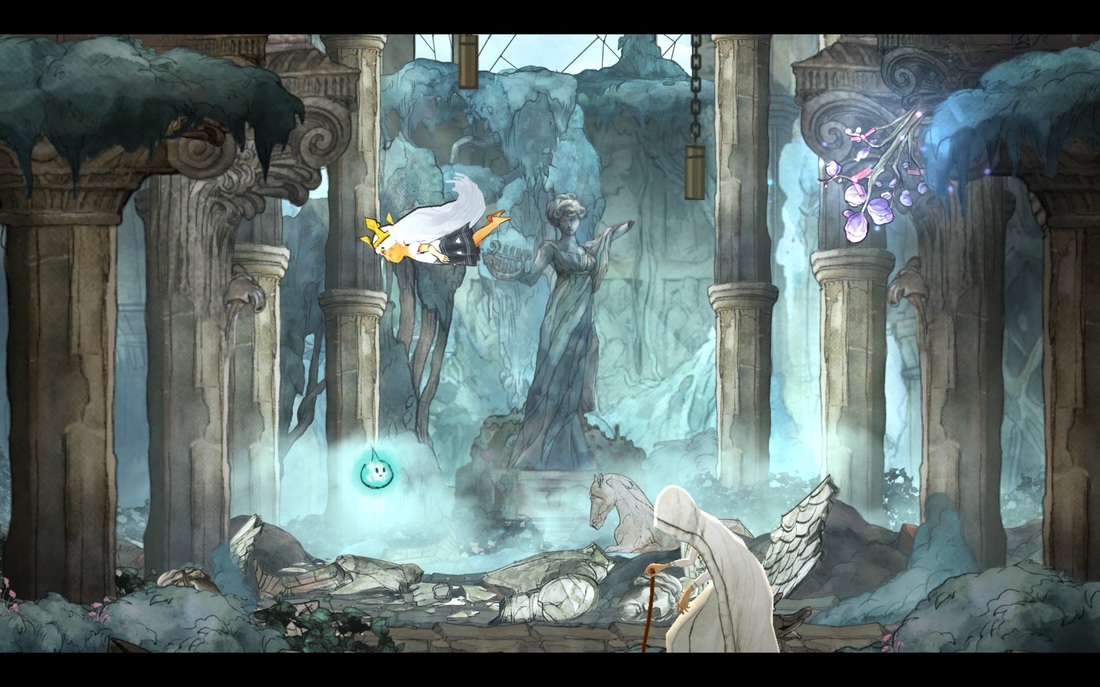 It's an interactive fairy-tale. It's an interactive fairy-tale.
Aurora is transported to a magical land, far away from her dying father and her doomed kingdom. Despite the distance, she wants to save everything she loves. In order to do that she will need to gather a strange band of allies together and defeat her evil step-mother.
1. Gameplay
Child of Light has some very positive things going for it, but the overall package outweighs its welcome by around 5 hours. The game is relatively simple and early chapters are very easy. It’s a beautiful game with a well written young female protagonist. But the combat is dull and gets repetitive very quickly, the side quests are lackluster, and the later battles get so difficult I struggle to believe that the target audience would ever be able to complete the game without help from an adult.
This might be the only game I have ever played where the main character is a young female human child that doesn’t focus on actions or events stereotypically attached to women. Aurora will never go shopping, will never get involved in a romance, and will never require a man to do a job because she physical/mentally/emotionally can’t. She might be a princess with fairy wings, but she wields a sword as large as herself and actively engages in combat with enemies of all types without even a hint of fear. In fact, if her character had been switched with a male one and the appropriate pronouns changed, everything would still flow smoothly.
The art style of this game is beautiful. Everything is done in a free flowing watercolor that makes every vista feel like a painting. Even areas that are specifically designed to be dark and foreboding flow like water. Even Aurora’s hair uses a flowing physics mechanic that makes it seem like her hair is flowing in water.
The problem is that all of these effects don’t actually make a game entertaining. The combat in the beginning of the game is almost exactly the same as the combat toward the end of the game. It’s almost impossible to figure out how much health an enemy has, what its weaknesses are, and which of your attacks are going to be effective. Sometimes enemies have special abilities that you don’t know about until you stumble upon them. For example, a number of enemies had an extra ability that triggered when the enemy’s attack was interrupted.
As the game progressed, the difficulty level increased exponentially. Part of it was that I stopped doing the pre-combat work that the game seemed to indirectly require (i.e. giving all of my character crystals that buffed certain attributes), but a huge part of it was that the enemies increased in strength very quickly after I left the mouse village. It eventually got to the point where I wasn’t sure if I could finish the final boss battle even if I wanted to, since the boss had a seemingly infinite amount of health and the ability to regenerate its allies with 800 health (even my strongest attacks were only dealing 100 to 200 damage maximum).
Despite my initial like for this game, the adjective I ultimately used to sum up this game is “dull”. It’s both ironic and sad that a game so visually stunning and beautiful can be so unbelievably uninspired from a gameplay standpoint. I would stick to Stacking and Costume Quest instead.
It took me around 10 hours to complete this game and, despite the fact that I would have preferred this game be cut in half, there were plenty of side quests that I missed or left incomplete. There was definitely more to do in this game, but I don’t see there being enough content for a second playthrough.
The early sections of this game weren’t particularly frustrating. A number of the side quests were difficult to complete, since they involved searching levels for creatures or objects without any real hint as to where those creatures or objects were, but this wasn’t enough to make me frustrated. What did frustrate me were the late-game boss battles, which would frequently seem completely stacked against the player. I often couldn’t even get an attack in because the enemies would chain their attacks so quickly.
Not having a third companion in combat was a decision I had trouble understanding as well. It’s possible that the game wasn’t correctly balanced for three companions, but when every battle was 3 vs 2 favoring the enemy it seemed like I should have had an additional companion for support spells or revives.
2. Parental Notices
Combat is the most prominent factor in this game, but it’s not even a major one. The player will engage in turn-based combat with enemies, but there is never any blood or gore. One character casts a spell or mimes an attack in the general direction of the opposition, and the other character reacts as if it took the hit.
This goes for all attack types, although the visual effect of the attack can vary depending on if the attack was a spell or a physical attack. Some attacks resulted in the game giving me word cues to show how effective the attack was (i.e. “Vulnerable to Lightning”), but this wasn’t always the case. The most seemingly violent of these was “devastation”, but I could never figure out exactly what that meant.
The violence in this game is definitely present, but it’s not going to make kids have nightmares.
Sexuality is not a factor in this game.
There are a number of characters that are drunk or smoking. These were almost exclusively around the mouse/gnome village, although some characters smoking pipes can be seen elsewhere. The player cannot drink or smoke ever.
However, the player can consume small potions that have a small variety of combat-related effects. These can do anything from increasing a character’s speed, healing damage, or regenerating mana points used for spells. There is no animation seen with consuming any of these potions.
Gambling is not a factor in this game.
3. Other Factors
There are no modding tools available for this game.
While many of the concepts in this game border on the ideas of spiritualism, I never noticed any overt talk of organized religion or gods. As a result, religion is not a factor in this game.
Anti-law is not a factor in this game.
There are no multiplayer modes for this game.
Extreme sports are not a factor in this game.
Magic is a major factor in this game. Almost all of the characters in this game are either modified by magic or can cast magical spells. Even the main character can cast spells to heal allies and hurt enemies.
The use of magic in combat is unavoidable. It would be extremely difficult to try and complete late-game combat sequences without resorting to some sort of offensive or defensive magical spell. And “defense”, one of the most basic combat maneuvers, involves the character casting a magical bubble shield to protect from incoming damage.
Both the main story and many of the smaller side quests also involve magic. The main character, Aurora, is transported to a magical world and has to use new powers, abilities, and strength to defeat monsters and save her kingdom from the evil queen. Aurora even gets fairy wings, which she can use to fly around the levels.
There are no additional factors in this game.
0 Comments
Leave a Reply. |
Like what we do? Want to see more? Donate to the site using the button below!
Not sure what a term means? Read the definitions!
Not sure what a review section is about? Find out more information!
|









 RSS Feed
RSS Feed